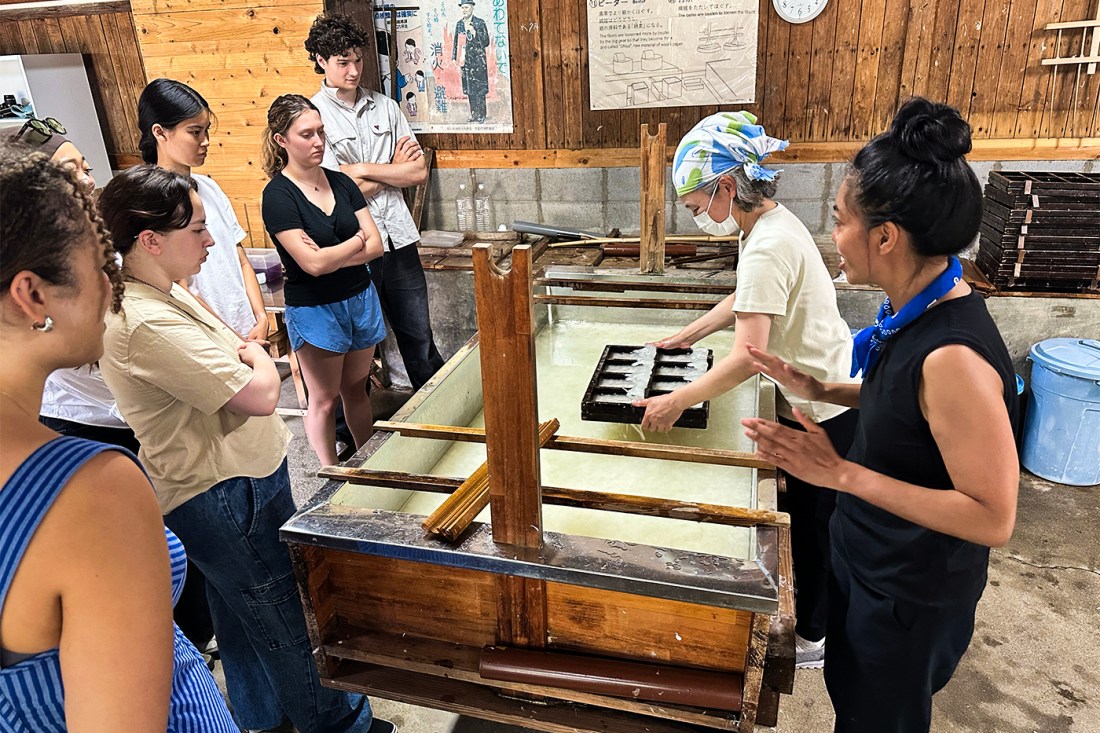How the Shoshin Dialogue deepened Northeastern students’ cultural connection to Japan

Growing up in Texas, Northeastern student Kristina Whitwell always heard stories about her parents’ eight years as expatriates in the Shibuya district of Tokyo.
This year, thanks to the university’s Shoshin Japan Dialogue of Civilizations course in Tokyo and Kyoto, Whitwell got to experience Japan and learn about its culture for herself.
“I had this curiosity toward Japan to learn more about it, to see what it was actually like after hearing about it my whole childhood,” Whitwell says. “I really knew that I wanted to take this opportunity.”
Dialogue of Civilizations courses offer students an immersive global educational experience with Northeastern faculty, bringing students to more than 80 different countries from Iceland to Japan to Mexico, just to name a few.
In the recent Shoshin Japan dialogue, students traveled to Tokyo and Kyoto to study Japanese cultural and artistic traditions — visiting Buddhist temples and Shinto shrines, observing and trying traditional crafts in rural villages and channeling their exploration of Japanese culture into creative experiments.



“The name Shoshin comes from the idea that you — even though you may have seen something many times before — you broach it with a beginner’s mind every time,” explains Jamal Thorne, associate teaching professor in Northeastern’s College of Arts, Media and Design.
“It’s the onion that you can just peel and peel, and every time you peel back a layer you learn something,” Thorne continues. “This dialogue is peeling back the layers of the way students understand their skills, that they understand their bodies, the way they understand themselves in relation to the world around them — and it’s challenging them to do that every single day, both in themselves and in the activities that we engage in.”
Creativity — or “exercising the creative muscles,” as Thorne called it — is a major aspect of the dialogue.
Some of this creativity is experienced through observing and trying traditional crafts. The students visited rural villages where making pottery, fabric-dyeing and papermaking have been practiced for generations.
“I’ve never done anything like all the workshops that we visited,” says Max Pedicelli, a rising second-year Northeastern student interested in experience design. “It was all very unique workshops that I don’t think I would ever have experienced unless I had gone with the dialogue.”



Pedicelli says that the experience with traditional crafts, particularly those involving sewing fabrics, not only taught him new techniques but also built his confidence.
Pedicelli says that will help him better utilize makerspaces in the EXP research complex and Snell Engineering Center on the Boston campus.
“There are a lot of sewing machines and clothing-related items in the makerspace that I was kind of intimidated to use, just because I wasn’t too sure about how to actually operate them,” Pedicelli says. “I’ll feel a lot more confident being able to walk in there and just kind of — even if it’s for my own personal projects — just be able to use those spaces more effectively.”
“It’s also going to be especially helpful for engineering classes where I’m going to have to build things, build physical products,” Pedicelli continues.
And some of this creativity is expressed through the students themselves — as each student must create their own artwork.
Featured Posts
Rising fifth-year student Ashley Kromah created a conceptual art installation focused on the Kamo River in Kyoto.
“Kyoto, as the old capital in the Imperial City, was very specifically designed in relation to feng shui, and the Kamo River represented the blue dragon, which protects it from negative energy and lies on the east side of the palace,” Kromah explains.
So, in her conceptual installation, Kromah envisions a large glass panel inscribed with an image of the dragon to allow visitors to see the dragon superimposed onto the river.
“This was an example of intertwining the blue dragon into the actual space and having it curl around and dive in and out of the river,” says Kromah, who is studying game art and animation. “It was bringing in the hundreds of years of history of that river to the forefront.”
Meanwhile, Whitwell collected paper scraps throughout the dialogue, turning them into a book of collages.
“I find the treasure in trash, and I put it all into my artwork as a way to kind of document my experiences and feelings and just put my imaginary mind into work on these collages,” Whitwell says. “It’s a meditative practice for me to really form together these colors and shapes in a cohesive way that flows, yet still lets these individual scraps have their individuality and meaning.”
That book has been meaningful not just to Whitwell. It is also meaningful to her parents.
“When showing my parents all the little things I had brought home with me — the bowls, the books, and my little collected papers — I could see such nostalgia on their faces,” Whitwell says.
Indeed, Whitwell says she’s gained more insight into her parents’ lives, personalities and even their habits by experiencing Japan through this dialogue. But that’s not the only insight she gained.
“I came to Japan thinking that its meaning for me would derive from my parents’ past,” Whitwell says. “But it grew to mean so much more to me from my own personal experiences and adventures. I have my own memories now!”











